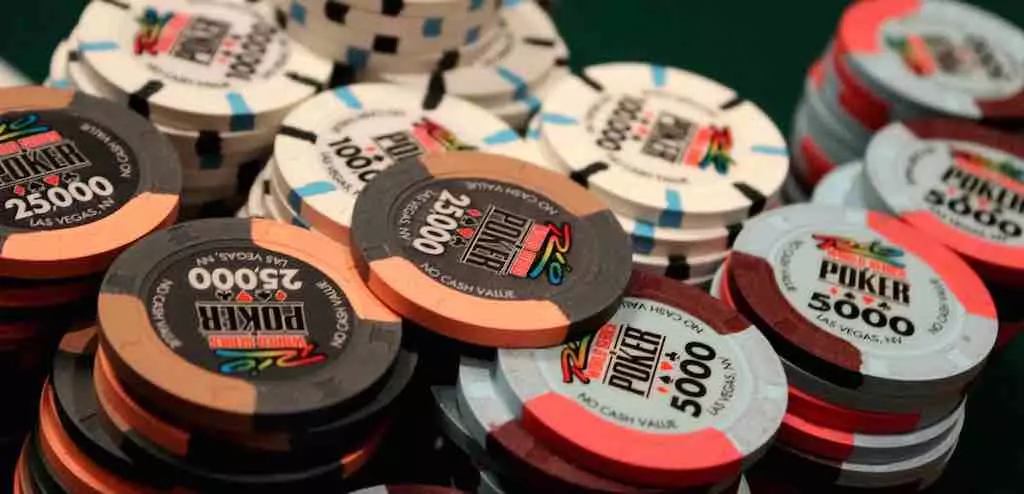Pro Tips to Win Satellite Tournaments – With Dara O’ Kearney
Every year, thousands of poker players from around the world make their way to Las Vegas to compete in the largest poker festival of the year, the World Series of Poker. Each tournament boasts a mouth-watering prize-pool, reflected in the number of entrants, and the buy-in of each tournament.
Buy-ins at WSOP don’t come cheap. The entry fee for events at the WSOP traditionally range from $1,000 to $50,000 for the most part, with some exceptions.
One way to get your WSOP tournament seat at a fraction of full-price is the qualify via a smaller “satellite” tournament which awards seats in the target tournament.
Who better than the man who wrote the book on satellites, Dara O’ Kearney, (poker pro, and author of “Satellite Poker Strategy” and “PKO Poker Strategy” and #14 on the Irish all time poker winnings money-list) to give expert tips and advice for players hoping to win WSOP seats via online satellite tournaments
1. Play Tight and Reduce Variance
The fundamental difference between satellites and regular multi table tournaments is that you are playing for prizes of equal value. That should be obvious, but it is important to repeat – you are playing for prizes of equal value.
There is no difference between the Viktor Blom wannabe who is raising every hand and has accumulated 60% of the chips in play, and the tight player who sneaks over the line with three big blinds. When the tournament is over they have both won a ticket to the same event. In reality, the difference between the two players is that the tight player is going to win more seats over the course of their satellite career.
Playing to min cash is a terrible long term strategy in MTTs but in satellites a min cash is the goal. The number of times you cash is much more important than your ability to crush the field, so that means reducing the number of times you bust by not taking needless risks.
You do have to build a stack to get you to the bubble, but you should look to adopt a tight aggressive strategy and remove any high variance plays from your arsenal. That means once the blinds have started to get big – no set mining with small pairs, no chasing draws with suited connectors, no coin flips and avoid defending with poor holdings because you are priced in. These moves may be ChipEV correct but they reduce your chances of having a survivable stack come bubble time.
Once the blinds are big and the stack sizes become shallow, consider open shoving your strong hands to avoid being reshoved over, even if you have 20 or 30 effective big blinds. If you open to 2.5x big blinds as your standard bet and get shoved on you are going to have to fold so often that this is sure fire way to get blinded down to a micro stack. Generally, you will get a lot more folds when you open shove in a satellite compared to a regular MTT, but that doesn’t mean do it with a wide range. Do it with hands you don’t mind getting called with.
Fold equity is the most important form of equity in a super satellite. You should be looking to give your opponents an opportunity to fold, even when you have a very strong hand. Trapping and inducing is a great strategy when you are trying to win the whole tournament but the more you avoid showdown, the more likely you are to survive to the bubble. If you see players open shoving 30 or 40 big blinds and showing up with strong hands like JJ or AQ, this is actually a sign of a seasoned satellite player. Don’t dismiss them as playing incorrectly – you should be doing the same.
Avoid Calling
By far the biggest errors you will see in satellites, and we will be covering this in depth later, is when players call all-ins too widely. The best way to reduce variance is to dramatically reduce the range you are prepared to call an all-in with when the amount you would stand to lose would hurt you severely or eliminate you. Quite simply you are putting yourself at the mercy of the deck when you call an all-in, and in satellites we want to avoid high variance showdown situations as much as possible.
This is why, when the blinds get big, it is more prudent to open shove a strong range, rather than open raise and then face the prospect of calling a reshove. When you are the first player to go all-in you put the pressure on the other players and most of the satellite savvy regulars will want to avoid a flip too. You give yourself two ways to win when you are the one putting pressure on others by going all-in – you can get them to fold or you can win the hand at showdown if they call. When you are the one facing an all-in call, there is only one way to win and that is to have the best hand at showdown.
This does not mean you should eliminate calling from your range. If you flop a full house and your opponent shoves you obviously will be calling. What this does mean is that you should narrow your own calling ranges. Think about what you would normally call with in the same spot in a regular MTT and reduce that by maybe a factor of three. So if you would normally call with 99+ and ATo+, maybe make the equivalent satellite range QQ+ and AKo+.
How to Estimate the Stack you Need
Unlike a normal tournament this is not a game where the goal is to accumulate all the chips. In fact playing in that manner is one of the worst things you can do in satellites. Satellite newbies will often make the mistake of slowing down too early in satellites, and then blinding away, or continuing to build a stack when they might be better advised to sit out and wait for the bubble to burst.
When you enter a satellite the first thing you need to be aware of is what the average stack will be on the bubble. Once you get to the average stack on the bubble, you can slow down and pick your spots more carefully, because while you have an average stack, you can safely bet some players will have very big stacks and way more will have micro stacks fighting for their lives. Once you get to about 70% of the target stack, slow down and don’t take any unnecessary risks.
The simplest way to work out the target stack you’ll need is to see how many buy-ins make up a package you are playing for and multiplying that number by the starting stack. So if you are in a $10 tournament to win a $100 token and the starting stacks are 10,000, that would be 10 players x 10,000 chips = 100,000 target stack. You are aiming for a 100,000 stack on the bubble and once you get to about 70,000 you should prioritise maintaining that stack rather than gambling trying to double up. This calculation is also usually a reliable indicator of what the blind level will be on the bubble. Usually the average stack has ten big blinds on the bubble so in the above example the blind level is likely to be 5,000/10,000.
When to “Lock Up”
While you should be aiming to get to the target stack, the actual stack you need to get over the line depends on a number of factors, most notably how many seats there are to be won. In general a satellite with five seats on offer will require you to attain a greater target stack than a satellite with 50 seats to be won, because the more players in the satellite there are, the wider the spread of stacks will be.
Once you get closer to the bubble a much simpler way of working out whether you are close to guaranteed a seat is this simple heuristic:
If there are more people outside the bubble than there are positions between you and the bubble, you usually are guaranteed a seat.
For example, if you are currently 70th of 120 players and 100 players win a seat. In this case, there are 30 players between you and the bubble and a further 20 players outside the bubble. That means that you could blind out and make the money, because those 20 players outside the bubble would need to make a move before you. A further 30 would be in trouble before you.
Your correct strategy in this situation would be to fold every hand, even premium hands like Aces and Kings (unless the person shoving into you has a very small stack which would mean nothing for you to call). The downside of calling and losing is greater than the upside of calling and winning by an order of magnitude. This cannot be stressed enough. Perhaps the most common way new players bubble a satellite starts with them playing a premium hand when they had no reason to. Most satellite bad beat stories start with “I had Aces” when in reality that player should have folded them preflop.



